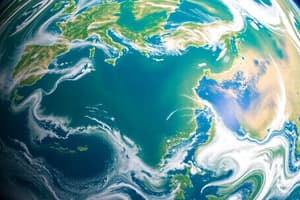Podcast
Questions and Answers
What was the initial temperature of the inside of the earth after its creation?
What was the initial temperature of the inside of the earth after its creation?
- 2000°F (correct)
- 1000°F
- 3000°F
- 4000°F
What materials are primarily responsible for the heat emitted during the decay of the earth's core?
What materials are primarily responsible for the heat emitted during the decay of the earth's core?
- Silicon and magnesium
- Iron and aluminum
- Carbon and oxygen
- Uranium, potassium, and thorium (correct)
Which of the following correctly describes the earth's layers?
Which of the following correctly describes the earth's layers?
- Crust, mantle, and metallic core (correct)
- Crust, core, and atmosphere
- Crust, mantle, and ocean
- Core, lithosphere, and asthenosphere
What characteristic of the earth's atmosphere is highlighted in the content?
What characteristic of the earth's atmosphere is highlighted in the content?
What is the function of the earth's magnetic fields?
What is the function of the earth's magnetic fields?
What are the two main divisions of the earth's structure mentioned?
What are the two main divisions of the earth's structure mentioned?
How did the core of the earth form?
How did the core of the earth form?
What did the depressions on the surface of the earth contain?
What did the depressions on the surface of the earth contain?
What is the layer of air that protects the earth from solar rays called?
What is the layer of air that protects the earth from solar rays called?
Which subsystem is primarily composed of all the water on Earth?
Which subsystem is primarily composed of all the water on Earth?
What is the outermost layer of the Earth called?
What is the outermost layer of the Earth called?
Which layer of the atmosphere is known for stable air and is optimal for planes to fly?
Which layer of the atmosphere is known for stable air and is optimal for planes to fly?
What separates the crust from the upper mantle?
What separates the crust from the upper mantle?
What is the main component of the Earth's core?
What is the main component of the Earth's core?
Which layer of the atmosphere is where meteors burn up?
Which layer of the atmosphere is where meteors burn up?
How thick is the outer core of the Earth?
How thick is the outer core of the Earth?
Which part of the mantle is composed of solid rock and is located between the core and the crust?
Which part of the mantle is composed of solid rock and is located between the core and the crust?
What is the primary factor that creates the Earth's magnetic field?
What is the primary factor that creates the Earth's magnetic field?
Flashcards are hidden until you start studying
Study Notes
Importance of Earth and Life Science
- Understanding the environment and living organisms helps in comprehending ecological balance.
- Provides foundational knowledge for future studies and environmental stewardship.
Origin and Structure of Earth
- Earth's formation linked to the creation of the Sun from a cloud of dust and gases.
- Initial Earth temperature approximated 2000°F; core primarily made of iron and silicates.
- Radioactive materials like uranium, potassium, and thorium in Earth's core decay, releasing heat.
- As the Earth cooled, denser iron sank, forming the core, while silicates formed the mantle and crust.
Key Characteristics of Earth's Structure
- Earth has two magnetic fields that repel solar wind, shielding the planet from harmful radiation.
- Atmosphere mainly composed of nitrogen and oxygen, stratified into layers.
- Earth consists of various minerals, melts, fluids, gases, and volatiles from the solar system's creation.
- Layered structure: crust, mantle, metallic core; divided into lithosphere (rigid) and asthenosphere (plastic).
Earth’s Subsystems
- Subsystems: geosphere, hydrosphere, atmosphere, and biosphere are vital for life.
- Atmosphere: Layer of air protecting from solar rays; circulates gases essential for life.
- Biosphere: Comprises all living organisms; interactions among species and other spheres are crucial for ecosystem balance.
- Geosphere (or Lithosphere): Consists of physical matter like rocks and soil, spanning from Earth’s core to atmospheric dust.
- Hydrosphere: Encompasses all water forms, including vapor, glaciers, lakes, rivers, and oceans.
Structure of the Atmosphere
- Comprises six layers differentiated by altitude:
- Exosphere: Extends to 500 km; Atmospheric merge with space.
- Thermosphere: Ranges 90 km above; location for satellites orbit.
- Mesosphere: 50-90 km above; meteors burn upon entry.
- Stratosphere: 12-50 km above; stable air for flight.
- Tropopause: 11-12 km above; boundary between troposphere and stratosphere.
- Troposphere: Extends from ground to 11 km; contains all weather phenomena.
Structure of the Geosphere
- Crust: Outer layer varies in thickness with thickest under mountain ranges and thinnest under mid-ocean ridges.
- Mohorovićić Discontinuity (Moho): Boundary between crust and upper mantle, discovered in 1909.
- Two crust types: continental crust and oceanic crust; primarily composed of oxygen and seven other elements.
- Mantle: Solid rock layer composed mainly of peridotite; contains convection currents moving cool and hot materials.
- Three mantle subdivisions: upper, transitional, and lower mantle.
- Core: Iron-rich sphere with radius of 3,471 km; outer core is liquid, creating Earth's magnetic field while inner core is solid.
Formation of the Universe and Solar System
- Estimated formation occurred approximately 4.6 billion years ago, leading to the development of the solar system and Earth.
Studying That Suits You
Use AI to generate personalized quizzes and flashcards to suit your learning preferences.



